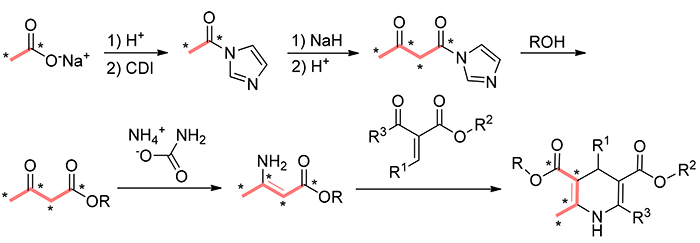| [1] |
Wan J.; Liu Y. RSC. Adv. 2012, 2, 9763.
doi: 10.1039/c2ra21406g
|
| [2] |
Eisner U.; Kuthan J. Chem. Rev. 1972, 72, 1.
doi: 10.1021/cr60275a001
|
| [3] |
Kappe C.-O. ChemInform 2001, 32, 1043.
|
| [4] |
Samrat A.-K, Pratibha B.-A. Mini-Rev. Med. Chem. 2014, 14, 282.
doi: 10.2174/1389557513666131119204126
|
| [5] |
Janis R.-A.; Triggle D.-J. J. Med. Chem. 1983, 26, 775.
pmid: 6304312
|
| [6] |
Boecker R.-H.; Guengerich F.-P. J. Med. Chem. 1986, 29, 1596.
doi: 10.1021/jm00159a007
|
| [7] |
Sausins A.; Duburs G. ChemInform 1988, 19, 269.
|
| [8] |
Godfraind T.; Miller R.; Wibo M. Pharmacol. Rev. 1986, 38, 321.
pmid: 2432624
|
| [9] |
Mager P.-P.; Coburn R.-A.; Solo A.-J.; Triggle D.-J.; Rothe H. Drug Des. Discovery 1992, 8, 273.
|
| [10] |
Stilo A.-D.; Visentin S.; Cena C.; Gasco A.-M.; Ermondi G.; Gasco A. J. Med. Chem. 1998, 41, 5393.
pmid: 9876109
|
| [11] |
Bossert F.; Meyer H.; Wehinger E. Angew. Chem., Int. Ed. Engl. 1981, 20, 762.
doi: 10.1002/(ISSN)1521-3773
|
| [12] |
Sunkel C.-E.; Miguel C.-J.; Santos L.; Garcia A.-G.; Artalejo C.-R.; Villarroya M.; Gonzalez-Morales M.-A.; Lopez M.-G.; Cillero J. J. Med. Chem. 1992, 35, 2407.
pmid: 1377748
|
| [13] |
Cooper K.; Fray M.-J.; Parry M.-J.; Richardson K.; Steele J. J. Med. Chem. 1992, 35, 3115.
pmid: 1507200
|
| [14] |
Lavilla R. J. Chem. Soc., Perkin. Trans. 1 2002, 1141.
|
| [15] |
Comins D.-L.; O'Connor S. Adv. Heterocycl. Chem. 1988, 44, 199.
|
| [16] |
Goldmann S.; Stoltefuss J. Angew. Chem., Int. Ed. Engl. 1991, 30, 1559.
doi: 10.1002/(ISSN)1521-3773
|
| [17] |
Chandra R. Adv. Heterocycl. Chem. 2001, 78, 269.
|
| [18] |
Fischer C.; Heuer B.; Heuck K.; Eichelbaum M. Biomed. Environ. Mass Spectrom. 1986, 13, 645.
pmid: 2952187
|
| [19] |
Ohtaka K.; Kajiwara M. J. Labelled Compd. Radiopharm. 2003, 46, 1177.
doi: 10.1002/(ISSN)1099-1344
|
| [20] |
Quan H.-Y.; Wang L.-Y.; Wang Z.-N.; Nin J.; Mei X.-D.; She D.-M. ChemistrySelect 2020, 5, 7222.
doi: 10.1002/slct.v5.24
|
| [21] |
Yuan S.-S.; Ajami A.-M. J. Labelled Compd. Radiopharm. 1984, 21, 525.
doi: 10.1002/jlcr.v21:6
|
| [22] |
Reynolds K.-A.; O'Hagan D.; Gani D.; Robinson J.-A. J. Chem. Soc., Perkin. Trans. 1 1988, 3195.
|
| [23] |
Huetter P.; Zeller K.-P. Synthesis 1985, 334.
|
| [24] |
Townsend C.-A.; Christensen S.-B.; Davis S.-G. J. Chem. Soc., Perkin Trans. 1 1988, 839.
|
| [25] |
Pillai A.-D.; Rani S.; Rathod P.-D.; Xavier F.-P.; Vasu K.-K.; Padh H.; Sudarsanam V. Bioorg. Med. Chem. 2005, 13, 1275.
doi: 10.1016/j.bmc.2004.11.016
|
| [26] |
Sanchez L.-M.; Sathicq Á.-G.; Romanelli G.-P.; González L.-M.; Villa A.-L. Mol. Catal. 2017, 435, 1.
|
| [27] |
Firuzi O, Javidnia K, Mansourabadi E. Arch. Pharm. Res. 2013, 36, 1392.
doi: 10.1007/s12272-013-0149-8
|
| [28] |
Gaveriya H.; Desai B.; Vora V.; Shah A. Heterocycl. Commun. 2011, 7, 167.
|
| [29] |
Jian Z.; Long F.-J. J. Chem. Soc. Pak. 2011, 33, 916.
|
| [30] |
Suárez M; Ricard M.-D.-A; Ramírez R.-O.-O; Martin N. New. J. Chem. 2005, 29, 1567.
doi: 10.1039/b506018d
|
| [31] |
Kumar R.; Andhare N.-H.; Shard A.; Richa; Sinha, A.-K.RSC Adv. 2014, 4, 19111.
doi: 10.1039/C4RA02169J
|
| [32] |
Sun J.; Zhang-Negrerie A.-D.; Dua Y. Adv. Synth. Catal. 2016, 358, 2035.
doi: 10.1002/adsc.v358.13
|
| [33] |
Litvi M.; Filipan M.; Pogoreli I.; Cepanec I. Green. Chem. 2005, 7, 771.
doi: 10.1039/b510276f
|
| [34] |
Zhou K.; Wang X.-M.; Zhao Y.-Z.; Cao Y.-X.; Fu Q.; Zhang S.-Q. Med. Chem. Res. 2011, 20, 1325.
doi: 10.1007/s00044-010-9477-0
|
| [35] |
Jin L.-Y.; Zhou H. China Prac. Med. 2011, 13, 216. (in Chinese)
|
|
金连玉, 周辉, 中国实用医药, 2011, 13, 216.).
|
| [36] |
Furlan B.; Grdadolnik, S0.-G.; Hocevar, S.Croat. Chem. Acta 2009, 82, 299.
|
| [37] |
Zhang Y.-L.; Zhang Y.; Chen J.-C.; Chen Z.; Sun T.-M. J. Shenyang Pharm. Univ. 2015, 32 ( 3), 188. (in Chinese)
|
|
张亚鲁, 张毅, 陈建超, 陈钊, 孙铁民, 沈阳药科大学学报, 2015, 32 ( 3), 188.).
|
| [38] |
Mueller C.-A.; Ana B.-B.-G.; Weinmann W. J. Mass Spectrom. 2004, 39, 639.
doi: 10.1002/(ISSN)1096-9888
|
| [39] |
Legeay J.-C.; Daniel C.; Paquin L.; Eynde J.-J.-V.; Bazureau J.-P. Heterocycl. Commun. 2009, 15, 91.
|
| [40] |
Yang C.-H.; Li Q.; Liu X.-H.; Zhao X.-K.; Cui Y.-X. J. Chin. Pharm. Sci. 2004, 13, 49.
|
| [41] |
Gotrane D.-M.; Deshmukh R.-D.; Ranade P.-V.; Sonawane S.-P.; Bhawal B.-M.; Gharpure M.-M.; Gurjar M.-K. Org. Process Res. Dev. 2010, 14, 640.
doi: 10.1021/op900283z
|
| [42] |
Xu F.; Hong Q.; Xu Y.; Zhu R.-F.; Shao G.-Q. Anhui Chem. Ind. 2013, 39, 23. (in Chinese)
|
|
许峰, 洪强, 徐勇, 朱仁发, 邵国泉, 安徽化工, 2013, 39, 23.).
|
| [43] |
Zhang D.-X.; Li Z.-Q. Guide China Med. 2011, 9, 49. (in Chinese)
|
|
张道旭, 李治乾, 中国医药指南, 2011, 9, 49.).
|
| [44] |
G Wang, X.-K.; Ou, W.-H.; Liu, F.; He, X.-M.; Pan, X.-H. Fine Chem. 2009, 26, 1005. (in Chinese)
|
|
王晓科, 欧文华, 刘烽, 何锡敏, 潘仙华, 精细化工, 2009, 26, 1005.).
|
| [45] |
Zhang D.-X.; Li Z.-Q. Guide China Med. 2011, 9, 49. (in Chinese)
|
|
张道旭, 李治乾, 中国医药指南, 2011, 9, 49.).
|
 )
)
 )
)
